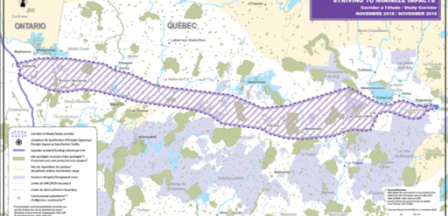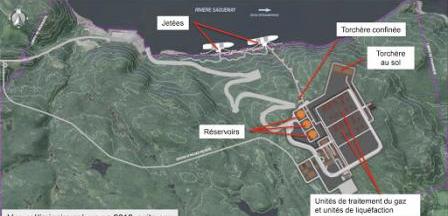
GNL QUÉBEC PROJECT REJECTED: ANOTHER GREAT PEOPLE-POWERED VICTORY OVER THE FOSSIL FUEL INDUSTRY
On July, 21st, the Legault government has finally rejected GNL Québec, the fossil gas liquefaction plant project in the Saguenay, and it has also closed the door on Gazoduq!
This announcement is a huge victory for environmental organizations, citizen groups in the Saguenay and Abitibi regions and tens of thousands of citizens who have been mobilizing against this project for years.
It is now time to move forward and develop projects for a resilient future. We must work to implement an ecological and social transition by putting forward sustainable economic development projects that respect nature. We are excited to turn the page on four years of relentless mobilization and are ready to participate, with local communities, in the development of forward-looking projects committed to a green transition in a 21st century economy.
The facts
The GNL Québec project consists of two projects: Gazoduq and Énergie Saguenay. The two are linked by a common objective: to liquefy and export natural gas from Western Canada to international markets. The Gazoduq project involves the construction of a new 750-km-long gas pipeline to link the existing principal section of TransCanada from Eastern Ontario to the Saguenay. The Énergie Saguenay project would then convert the natural gas to liquid form in order to ship it to the United States, Europe and Asia. The plant would be located on the same site as a sea terminal (whose infrastructure remains to be built), on land owned by the Saguenay Port Authority.
The GNL Québec project has ignited many concerns for its impacts on the environment:
1. Impacts on climate change
- Natural gas is composed of methane, a greenhouse gas (GHG) whose global warming potential far exceeds that of CO2.
- There is a high risk of methane leaks from the time of extraction to the time of consumption.
2. Impacts on ecosystems and communities
- At-risk species whose habitat is located in the Gulf of St. Lawrence, such as beluga whales, would be threatened by the increased marine transportation.
- Local and indigenous communities, along with their tourism-based economy, risk being negatively affected.
The facts on the project location
- 443 Quebec communities and 5 Aboriginal communities are located along the pipeline route and risk being affected.
Corridor being studied for Gazoduq

Source: Gazoduq inc.
Location of liquefaction plant

Source: Énergie Saguenay
Liquefaction plant

Source: Énergie Saguenay
- To get to the construction site for the planned liquefaction plant and export terminal south of the Saguenay River near the Grande Anse marine terminal, tankers would pass through the Saguenay – St. Lawrence Conservation Area (a category II marine conservation area in Quebec) as well as the Saguenay Fjord National Park.
- Over 160 supertankers per year (three or four a week) would make their way to the Énergie Saguenay marine terminal via the Saguenay – St. Lawrence Conservation Area and the Saguenay Fjord National Park, thus imperilling such species as the beluga whales – an at-risk species according to the Species At Risk Act. Other at-risk species, such as the blue whale, fin whale, harbour porpoise and various seabirds, also risk being affected.
The facts on liquefied natural gas
Natural gas is a fossil fuel whose main ingredient (84%) is methane, a gas whose global warming potential is 84 times higher than that of CO2 over a 20-year horizon, and up to 34 times higher over a hundred-year horizon. [1]
The GHGs emitted by liquefied natural gas stems from the CO2 and methane emitted at various points in the life cycle of liquefied natural gas:
- During extraction, whether by conventional methods or not (fracking);
- During transport via pipeline;
- During processing at the liquefaction plant;
- During storage;
- During tanker loading, transport and unloading;
- During regasification;
- Downstream, where the gas is burned for industrial, commercial or residential purposes (and potentially displacing renewable energy sources).
According to an environmental impact study that Énergie Saguenay commissioned the International Reference Centre for the Life Cycle of Products, Processes and Services (CIRAIG) to conduct, a study that took account of all the GHG emissions upstream and those generated by the Énergie Saguenay plant, annual GHG emissions associated with the Énergie Saguenay project amount to 7.8 million tonnes of CO2 equivalent. This is equivalent to cancelling out in a single year the majority of Quebec’s emissions reductions since 1990.
Steps in the assessment of the GNL project
As things stand today, while the pipeline and liquefaction plant are two components of the same project with the same objective, the environmental assessment will be done on a piecemeal basis. There will be four different processes:
- Gazoduq assessment at the federal level
- Gazoduq assessment at the provincial level
- Énergie Saguenay assessment at the federal level
- Énergie Saguenay assessment at the provincial level
1. Gazoduq federal assessment:
- ➔ The project will be assessed by the National Energy Board (NEB) on the basis of the pre-application preliminary documents filed by Gazoduq Inc. in November 2018;
- Next steps: We are awaiting the NEB’s announcement about the launch of a Gazoduq review process. These steps ordinarily take place before the company has completed its final environmental impact statement.
2. Gazoduq provincial assessment:
- The project will be assessed by the Ministère de l’Environnement et de la Lutte contre les changements climatiques (MELCC), which indicated that it would proceed in accordance with the Environment Quality Act.
- Gazoduq Inc. filed a project notice with the MELCC in November 2018.
- The MELCC published its Directive pour la réalisation d’une étude d’impact sur l’environnement [Guideline on conducting an environmental impact statement] for the pipeline project on December 6, 2018.
- The MELCC carried out online consultations on the questions that the impact statement should broach. Équiterre took part in these consultations, which ended on January 18, 2019. In all, 355 individuals and 40 organizations provided their comments.
- The MELCC published a summary of the results of the public consultations on February 7, 2019. Les observations sur les enjeux que l’étude d’impact devrait aborder. [Observations on the issues that the impact statement should address]
- Next steps: We expect the government to determine which issues raised by the public consultations warrant a mandatory response by the proponent in its impact analysis. Gazoduq Inc. will then produce its complete environmental impact statement.
3. Federal assessment of Énergie Saguenay
Unlike in the case with Gazoduq, the Énergie Saguenay project is submitted for federal review and approval by two different agencies: the Canadian Environmental Assessment Agency (CEAA) and the NEB.
- The NEB issued the project an export licence in 2015.
- GNL Québec Inc. filed its project description with the CEAA in November 2015.
- The CEAA published the final guidelines on the environmental impact statement for this project on March 14, 2016.
- The CEAA stated that it was currently reviewing the étude d’impact environnemental complète [complete environmental impact statement] submitted to it by GNL Québec on February 20, 2019.
- Since the assessment by the CEAA is subject to the previous environmental assessment regime, we must await passage of Bill C-69 for the project to be subjected to an upstream GHG analysis.
- Next steps: Once the Agency has determined that the environmental impact statement meets the requirements of the Final Environmental Impact Statement Guidelines (2016), there will be a public comment period on the environmental impact statement.
4. Provincial assessment of Énergie Saguenay
The Environment Quality Act (LQE) and the new Regulation respecting the environmental impact assessment and review of certain projects (R. 23.1) allow Quebec to carry out environmental impact assessments on Énergie Saguenay’s principal facilities and sea terminals.
- In November 2015, GNL Québec Inc. filed a project notice with the MELCC, which is now part of the new Environmental Assessment Register.
- In December 2015, the MELCC published directives under the LQE to inform GNL Québec Inc. of the nature, scope and extent of the project’s environmental impact statement.
- On or about February 20, 2019, GNL Québec Inc. seems to have submitted the complete environmental impact statement, dated January 2019, to the MELCC. This statement seems to be the exact same complete version as that submitted for the federal process.
- Next step: The Minister will review the environmental impact statement documents and determine whether they are complete.
How is Équiterre involved in the project?
- Équiterre is working with both levels of government to ensure a solid environmental evaluation process.
- Équiterre is doing research and educating the public about the different elements and issues involved in the project.
- In collaboration with a coalition of local and provincial organizations, Équiterre is working to mobilize citizens against the project.
Sources:
-
Groupe d'experts intergouvernemental sur l'évolution du climat, 2013.
-
Étude d’impact environnemental produite par Énergie Saguenay, 2019.
for more information
- Blog post: Why Quebec’s natural gas export project doesn’t make sense
- Questions & Answers: GNL Québec - What you need to know
- Équiterre debates on RDI Économie (in French): Pour ou contre Énergie Saguenay?
- Blog post: A liquified natural gas plant on the Saguenay. Seriously? Why GNL Québec’s project must be stopped





